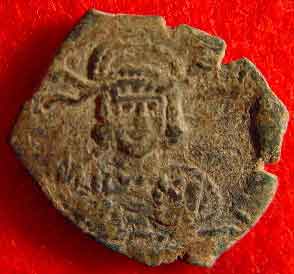.

Constantine IV on a contemporary coin
Constantine IV (649-685) was Byzantine emperor from 668-685. He had been named a co-emperor with his father Constans II in 654, and became emperor when Constans was assassinated in 668.
The most immediate threat to the empire under his reign were the Arabs, who sent a fleet to attack Constantinople by sea in 674. While Constantine was diverted by this, the Slavs attacked Thessalonika.
Constantinople survived the Arab siege until 678, when the Byzantines employed Greek fire against the Arab fleet at the Battle of Syllaeum. This was one of the first times Greek fire was used in combat. The Arabs withdrew, and were almost simultaneously defeated on land in Anatolia.
A solidus showing Constantine and his brothers, minted before 683 when the latter were mutilated.
In 680 Constantine called the Sixth Ecumenical Council (also known as the Third Council of Constantinople), reaffirming the doctrines of the Council of Chalcedon in 451. This solved the controversy over monothelitism; conveniently for the empire, most monothelites were now under the control of the Arab caliphate.
In 681, Constantine was forced to acknowledge the new Bulgarian Empire in the Balkans after having suffered a disastrous defeat in 680.
His brothers Heraclius and Tiberius had been crowned with him as Augusti at the demand of the populace, but in 683 Constantine had them mutilated so they would be ineligible to rule. This ensured the succession of Justinian II when Constantine died of dysentery in 685.
Byzantine Emperor
Preceded by: Constans II
Succeeded by: Justinian II
| Ancient Greece
Science, Technology , Medicine , Warfare, , Biographies , Life , Cities/Places/Maps , Arts , Literature , Philosophy ,Olympics, Mythology , History , Images Medieval Greece / Byzantine Empire Science, Technology, Arts, , Warfare , Literature, Biographies, Icons, History Modern Greece Cities, Islands, Regions, Fauna/Flora ,Biographies , History , Warfare, Science/Technology, Literature, Music , Arts , Film/Actors , Sport , Fashion --- |
Retrieved from "http://en.wikipedia.org"
All text is available under the terms of the GNU Free Documentation License

